Are you thinking about collecting 1986 pennies or curious about how much your 1986 penny is worth?
We have all the information you need on the value of 1986 pennies!
Although 1986 pennies are relatively modern coins, they generally don’t hold high value and likely won’t make you rich.
The good news is that 1986 pennies are affordable, making them easy to add to your Lincoln penny collection without spending much.
This guide covers the true value of the 1986 Lincoln Memorial penny, including its distinctive features, valuable error types, and grading tips.
Here’s a quick 1986 Penny Value Chart (all values are for red coins):
| Mint Mark | MS60 | MS65 | MS66 | MS67 / PF70 |
|---|---|---|---|---|
| 1986 No Mint Mark | – | $10 | $20 | $40 |
| 1986-D Penny | – | $10 | $15 | $20 |
| 1986-S Proof Penny | – | – | – | $185 |
The History of the 1986 Penny

The 1986 penny is part of the long-running Lincoln penny series, which the U.S. Mint first introduced in 1909.
From 1909 to 1958, these coins were known as Wheat Pennies because their reverse side featured two wheat ears.
As early as 1952, the Mint considered replacing the wheat ears with a new design, but it wasn’t until 1958 that a unanimous decision was made to refresh the Lincoln penny’s look.
The Mint commissioned the well-known sculptor Frank Gasparro to create the new design. The Lincoln Sesquicentennial Commission and the Treasury Department also played key roles in shaping and approving the design.
The updated reverse features the Lincoln Memorial in Washington, D.C., constructed between 1914 and 1922. Although Gasparro had never seen the Memorial in person, his depiction on the penny was generally well executed.
The new design was approved by the Secretary of the Treasury and President Eisenhower, and it was released into circulation in February 1959, commemorating Lincoln’s 150th birthday.
When copper prices rose sharply in 1973, the intrinsic value of the penny increased, causing many people to hoard them.
In response, the Mint experimented with various metal compositions over the years to discourage hoarding and address shortages. In 1983, due to another spike in copper prices, the Mint switched the penny’s composition to a zinc core with a copper plating, which remains the formula used today.
Like other Lincoln pennies, the 1986 penny holds significant historical and sentimental value, making it a great addition to any collection.
Next, let’s explore the key features of the 1986 Lincoln penny.
The Features of the 1986 Penny
The Obverse of the 1986 Penny
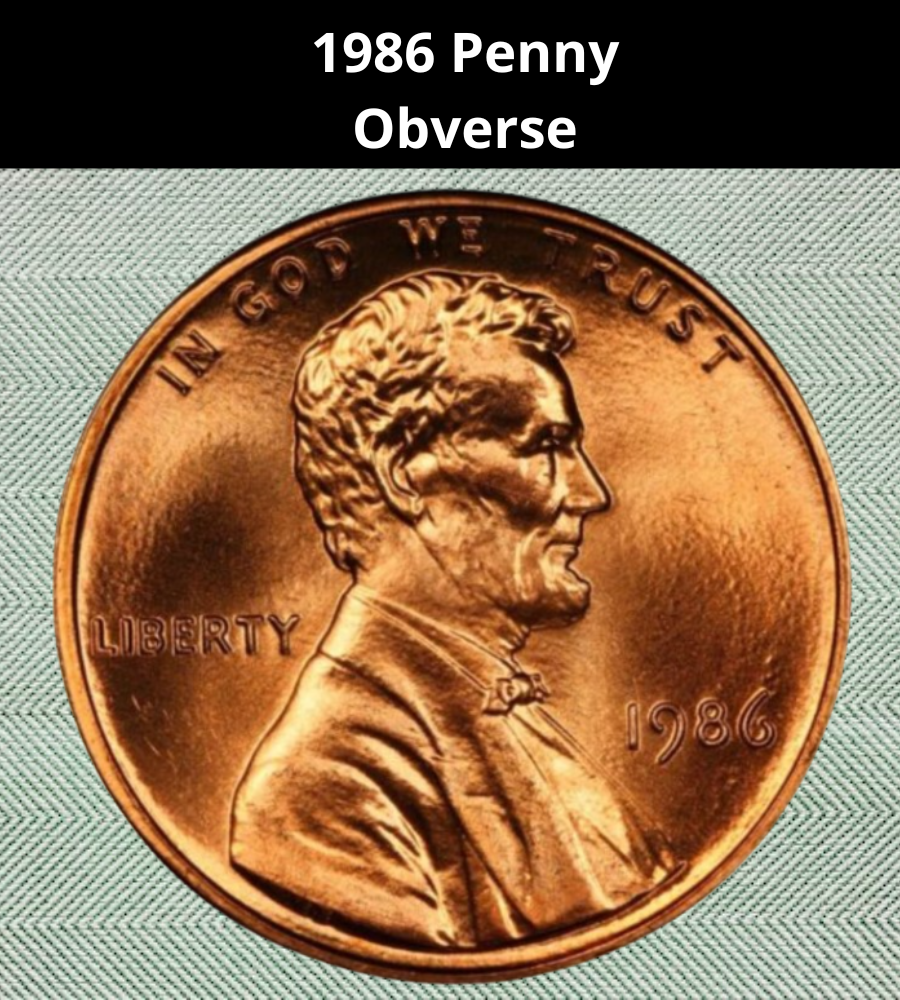
The front side of the 1986 penny features a prominent image of Abraham Lincoln facing right. He is shown wearing a bowtie and suit jacket.
Above his head is the phrase “IN GOD WE TRUST,” reflecting the nation’s motto.
To the left of Lincoln’s portrait, the word “LIBERTY” is displayed, and the date 1986 is stamped on the right side.
The Reverse of the 1986 Penny
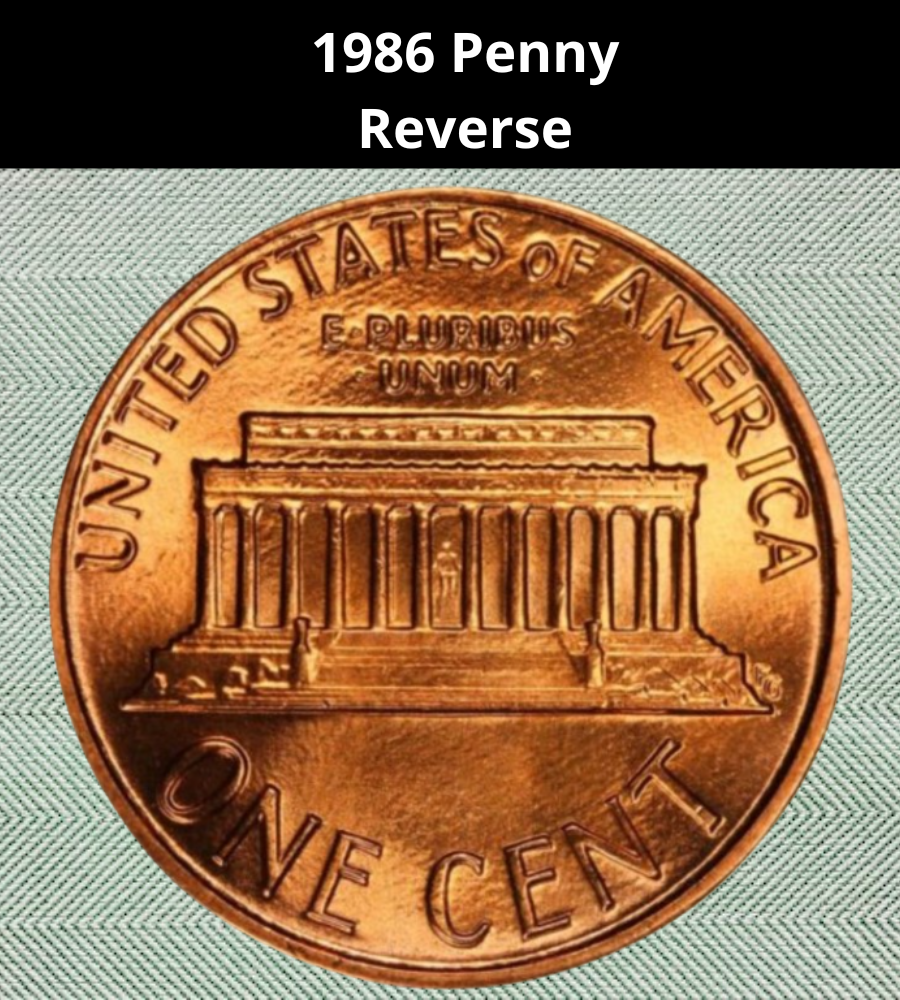
The back side of the 1986 penny is more intricate than the front. It prominently features the Lincoln Memorial as its main design.
At the top of the coin, you’ll find the inscription “UNITED STATES OF AMERICA,” followed underneath by the motto “E PLURIBUS UNUM,” which translates to “Out of many, one.”
If you look closely, you can see the statue of Lincoln seated within the Memorial. On the far right side of the coin, the initials “FG” for the designer Frank Gasparro are visible.
Along the bottom edge, the coin’s value is stated as “ONE CENT.”
Additional Details About the 1986 Penny
This penny measures 19.00 millimeters in diameter and weighs about 2.5 grams.
It has a smooth edge and is made from zinc with a thin layer of copper plating.
When freshly minted, these pennies have a bright reddish hue thanks to their copper surface. However, over time, they often darken to shades of brown or a mix of red and brown due to exposure and handling.
1986 Penny Grading Guide
If you’re thinking about collecting 1986 pennies, it’s wise to concentrate on uncirculated coins. Pennies from 1986 that have been circulated typically show significant wear and rarely carry any added value.
In coins of average circulated condition, many details will be worn down—the letters may blend into the edge, the date might be faint or completely gone, and on the reverse, features like the Lincoln Memorial will be barely visible or missing entirely.
To earn an uncirculated grade, your 1986 penny must display outstanding luster, sharp details, and overall visual appeal. It should be free from marks, scratches, or hairlines, with a flawless surface and well-formed planchet.
| Grade | Description |
|---|---|
| 1 | Basal State-1 |
| 2 | Fair |
| 3 | Very Fair |
| 4, 5, 6 | Good |
| 7, 8, 10 | Very Good |
| 12, 15 | Fine |
| 20, 30 | Very Fine |
| 40 | Extremely Fine |
| 50 | About Uncirculated |
| 60 | Mint State |
| 65 | Mint State |
| 70 | Mint State |
Be sure to consult our detailed grading guides to accurately determine your coin’s grade. This step is crucial for establishing its true value.
1986 Penny Value Guides
1986 No-Mint Mark Penny Value
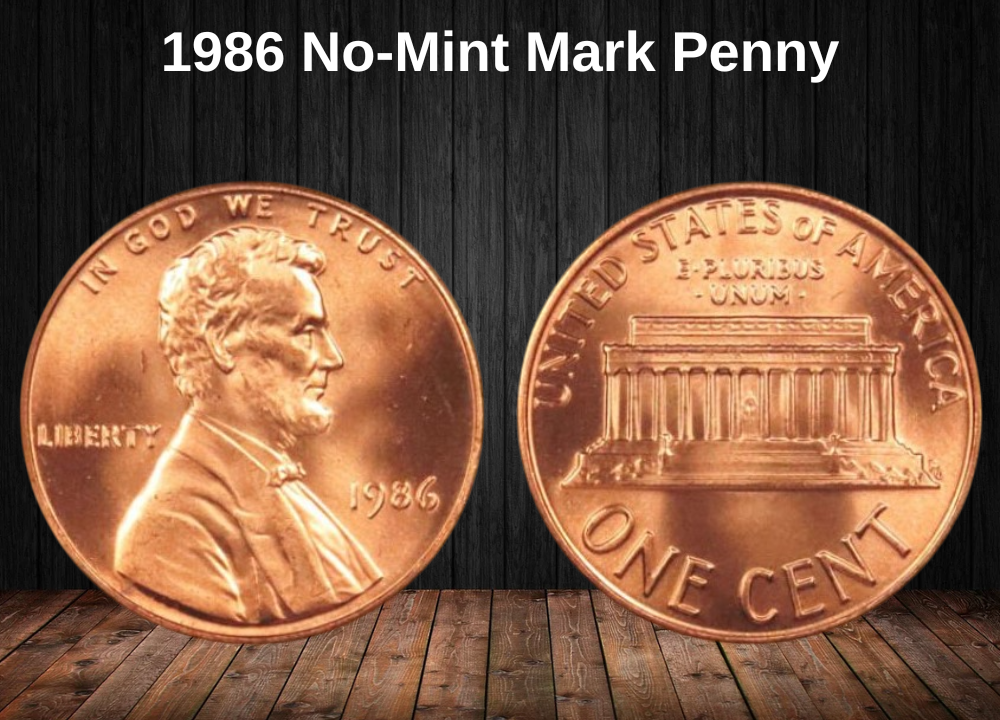
The Philadelphia Mint produced an impressive 4,491,395,493 Lincoln pennies in 1986, a record-setting number that heavily influences the coin’s value.
As is customary, Lincoln pennies minted in Philadelphia do not feature a mint mark on either the front (obverse) or back (reverse) of the coin.
Because of this large production and the coin’s relatively recent date, 1986 pennies without a mint mark are still commonly found in circulation. These circulated coins typically hold a value between 5 and 10 cents, roughly their face value.
The sheer volume of these no-mint mark pennies means they are available in all conditions, including mint state, which keeps prices affordable—even for new collectors. For instance, a 1986 penny graded MS66 in red is worth approximately $20.
Full red examples from 1986, however, are much rarer, with fewer than 100 known to exist. Acquiring one graded MS68 usually costs around $175.
The Professional Coin Grading Service (PCGS) reports that the priciest 1986 penny is a full red MS68 specimen, which sold at an eBay auction for a staggering $2,400.
1986-D Penny Value
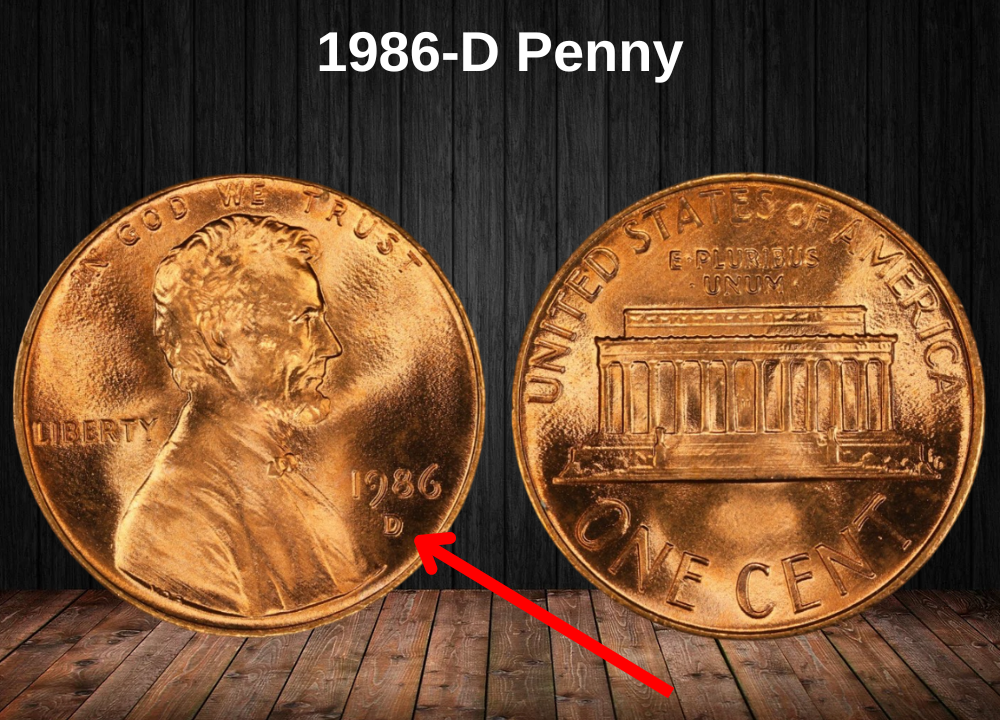
The Denver Mint produced a staggering 4,442,866,698 pennies in 1986, making these coins extremely common. As a result, most circulated 1986 Lincoln pennies from Denver are worth close to face value, typically between $0.05 and $0.10.
However, it’s worth noting that the Philadelphia Mint generally struck higher quality coins compared to Denver. Despite this, 1986 pennies remain very affordable even in mint state condition — you can acquire a brown, gem-quality example for about $7.50.
Red-colored pennies from the Denver Mint, on the other hand, are much more valuable. These red coins can fetch up to $100 on the open market. In fact, in 2021, a collector paid an impressive $7,840 for a red gem-quality example graded MS69.
1986-S Proof Penny Value
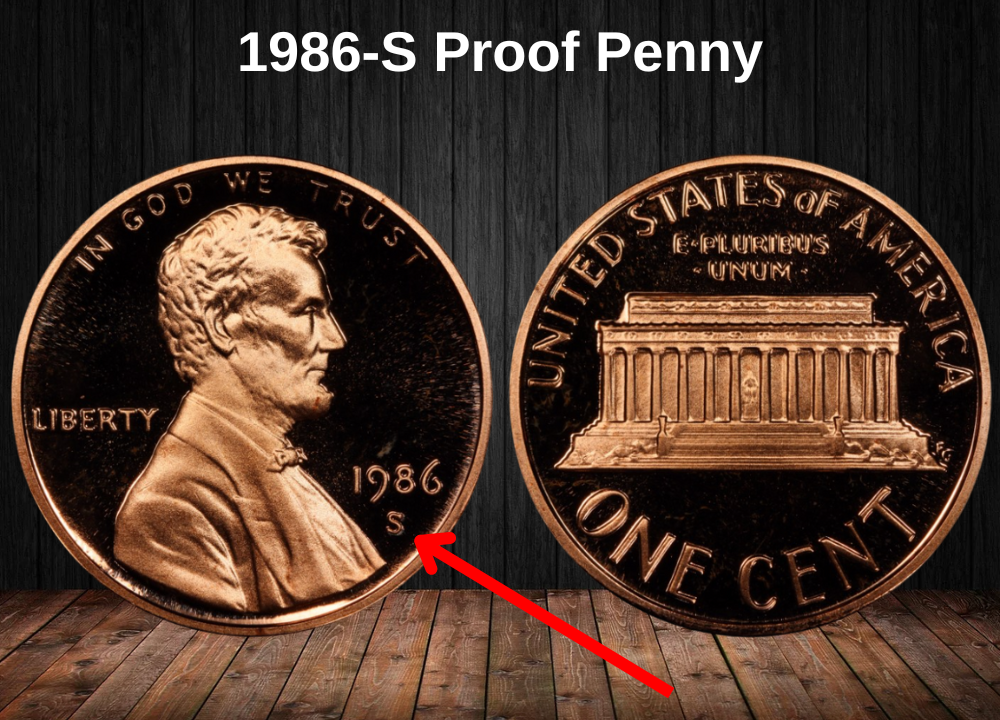
Besides the standard circulation coins, the U.S. Mint also released proof pennies in 1986 specifically for collectors. The San Francisco Mint produced around 3,792,233 of these proof coins, making them quite common and easy to find.
Proof pennies stand out due to their shiny finish and frosted details, and they are struck with greater precision, resulting in minimal flaws or errors. Although proof coins generally hold more value than regular strikes, in years with large production like 1986, they remain affordable for most collectors.
For instance, a 1986 proof penny graded PF66 can be purchased for roughly $5, while one graded PF68 typically costs about $7. Truly exceptional, gem-quality proof pennies from this year are very scarce, with only a few known to exist, and these rare pieces can sell for as much as $185.
Rare 1986 Penny Errors List
1986 Off-Center Strike Penny Error
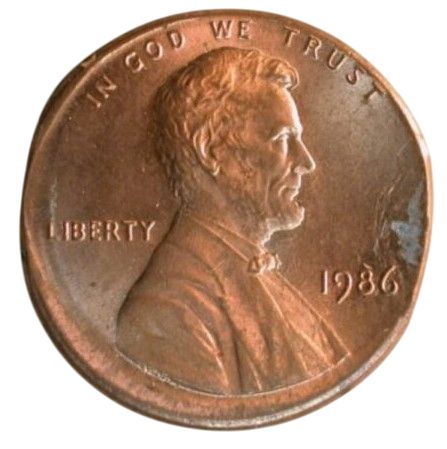
Off-center strike errors happen when the planchet isn’t properly positioned under the striking die, resulting in the coin’s design being pressed off-center.
The value of an off-center coin depends largely on how far the design is shifted from the center. Generally, errors where the design is more than 50% off-center tend to be more valuable to collectors.
For 1986 pennies, some examples show about a 30% off-center strike error. These coins can fetch prices up to $65.
1986 Wide AM Penny Error
This error is specific to Lincoln pennies and relates to the spacing between the letters A and M in the phrase UNITED STATES OF AMERICA.
On some coins, the gap between the A and M is noticeably wider than usual, while on others, the letters are unusually close together. These variations are thought to be caused by changes in the die during the coin’s production.
Both the wide and narrow AM varieties attract strong interest from collectors. In particular, a wide AM 1986 penny in mint condition can command prices up to $260.
1986 Missing Copper Clad Penny Error
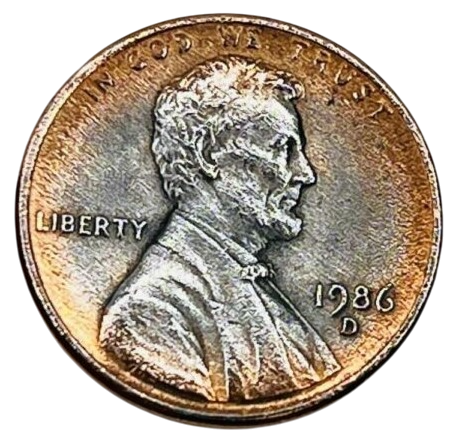
The 1986 Lincoln pennies are made with a zinc core covered by a thin copper outer layer.
Sometimes, this copper coating separates or is missing on parts of the coin, which is known as a delamination error. This happens due to impurities in the metal alloy during the minting process.
A penny showing this kind of copper layer separation is especially interesting to collectors.
If you have a 1986 Lincoln penny with a missing or peeling copper layer in mint condition, it can be valued at $100 or more.
1986 Double Struck Broadstrike Penny Error
A broadstrike error happens when the coin is struck outside the collar, causing a flattened rim and a stretched, distorted diameter.
Sometimes, the coin doesn’t leave the collar properly and is struck a second time, creating a double-struck broadstrike error.
A 1986 penny with this error typically sells for around $100, but if it’s in mint condition, the value can rise to $250 or more.
Where to sell your penny?
Now that you know the value of your penny, you might be wondering where to sell it. Don’t worry: here’s a guide to some of the best online platforms where you can easily sell your coins, along with their advantages and disadvantages.
Discover the best platforms for selling coins online (pros and cons).
1. What subtle minting variations can be found in 1986 pennies that affect their rarity and value?
The 1986 penny includes several minor repunched mint marks (RPMs) and die cracks that are often overlooked. These small errors, especially on Denver (D) mint coins, can significantly boost value in higher grades.
2. How did changes in the Mint’s planchet production in 1986 influence the quality of pennies?
In 1986, improvements in planchet annealing and cleaning processes helped produce pennies with fewer surface blemishes and better copper plating adhesion, resulting in coins more resistant to corrosion and spotting.
3. Are there any known 1986 penny varieties with doubled dies or other notable die errors?
Yes. While less dramatic than the famous doubled dies of earlier years, 1986 pennies feature some doubled die obverse varieties that show mild doubling on the date and the word “LIBERTY,” often visible only under magnification.
4. What are the key visual differences between Philadelphia and Denver 1986 pennies that collectors look for?
Besides the mint mark (D for Denver, none for Philadelphia), Denver coins often show stronger strike details and a slightly sharper rim due to differences in die polishing and maintenance schedules.
5. How do toning and environmental factors affect the desirability of 1986 pennies among collectors?
Natural toning that develops over decades can enhance the coin’s eye appeal, especially when it shows subtle reds, oranges, and purples without obscuring design details. Conversely, harsh or uneven toning can reduce value.
6. Are 1986 pennies frequently counterfeited or altered, and how can collectors verify authenticity?
While 1986 pennies are not a common target for counterfeiting, altered coins—such as added mint marks or artificially enhanced toning—do exist. Authentication includes examining luster, surface texture, and mint mark placement under magnification.
7. What is the significance of the 1986 penny in the context of the 20th-century Lincoln cent series?
The 1986 penny represents the midpoint in the copper-plated zinc era, marking a time when the Mint refined production methods to balance cost efficiency with coin quality, setting standards that remain in place today.


















































